Humans, Elephants, and Honeybees: Coexisting Via Avoidance
Whether due to agricultural development or urbanization, widespread habitat destruction repeatedly forces wildlife to confront human civilizations more and more often. With no choice but to occupy the same space, humans and elephants interact far more frequently than ever before. Drawn to farmers’ lands full of growing crops, herds of elephants will enter farmland areas to eat the produce. Entire fields can be wiped out quickly and completely, leaving farmers with no product to sell and communities with a significant lack of food. Not only do elephants consume valuable crops such as maize, sugarcane, and other vegetation, but they also trample the surrounding area, rendering the land difficult to use for any agricultural purpose after they leave. Desperate to protect their livelihoods, farmers will attempt to deter elephants from destroying their crops. 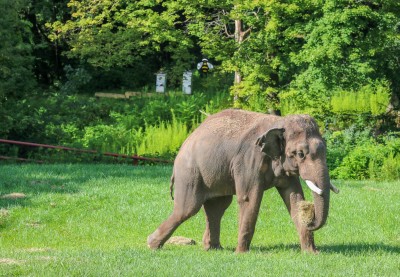 Unfortunately, those interactions can quickly become deadly for both elephants and people. In Sri Lanka alone, 155 humans and 388 wild elephants died as a result of human-elephant conflict (HEC) during 2024 (Rodrigo, 2025). This statistic does not even account for human injuries, elephant injuries, property damage, or financial losses caused by HEC. Common mitigation techniques range from surrounding seed areas of farmland in barbed wire to creating loud noise to scare away elephants, to using controlled fire and smoke, and more (Nabanita and Chakraborty, 2021). Although somewhat effective, many of these techniques still rely on harming elephants once they breach farmland, meaning that significant damage still occurs and both species still sustain injuries or death. Moreover, these mitigation techniques can be expensive and require substantial effort to maintain.
Unfortunately, those interactions can quickly become deadly for both elephants and people. In Sri Lanka alone, 155 humans and 388 wild elephants died as a result of human-elephant conflict (HEC) during 2024 (Rodrigo, 2025). This statistic does not even account for human injuries, elephant injuries, property damage, or financial losses caused by HEC. Common mitigation techniques range from surrounding seed areas of farmland in barbed wire to creating loud noise to scare away elephants, to using controlled fire and smoke, and more (Nabanita and Chakraborty, 2021). Although somewhat effective, many of these techniques still rely on harming elephants once they breach farmland, meaning that significant damage still occurs and both species still sustain injuries or death. Moreover, these mitigation techniques can be expensive and require substantial effort to maintain.
Although HEC might first appear to pose humans and elephants at opposing sides of a problem, a closer look reveals that this is not the case. What keeps elephants and humans most safe is the same solution: to limit interaction as much as possible, thereby preventing interactions from turning violent. HEC is neither a human problem nor an elephant problem. HEC is an interspecies problem. As conservation researchers and farmers work together to find solutions to HEC, one thing is clear: any solution must consider both farmers’ and elephants’ safety if it is to set the stage for peaceful coexistence between the two species. It’s not enough for conservation efforts to limit their focus to animals at the expense of the human communities. To make a true and sustainable difference, conservation must purposefully reconcile both humans’ and animals’ needs.
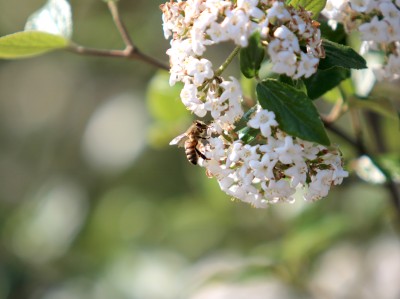 With that goal in mind, one HEC mitigation technique has recently been gaining traction due to the benefits it provides both humans and elephants. Perhaps most surprisingly, this mitigation technique introduces a third species into the mix: honeybees. To discourage elephants from approaching crops, some farmers have implemented beehive fencing as an eco-friendly, nonviolent alternative to other HEC prevention methods. Although no crops border the Rosamond Gifford Zoo’s Helga Beck Asian Elephant Preserve, guests will spot honeybee hives directly behind the elephant habitat, marked by a large honeybee sign. These honeybees may not actively prevent our herd of Asian elephants from accessing farmland, but they do serve an important purpose to inform guests about HEC and beehive fencing’s rising prominence as HEC mitigation across elephant’s wild habitats.
With that goal in mind, one HEC mitigation technique has recently been gaining traction due to the benefits it provides both humans and elephants. Perhaps most surprisingly, this mitigation technique introduces a third species into the mix: honeybees. To discourage elephants from approaching crops, some farmers have implemented beehive fencing as an eco-friendly, nonviolent alternative to other HEC prevention methods. Although no crops border the Rosamond Gifford Zoo’s Helga Beck Asian Elephant Preserve, guests will spot honeybee hives directly behind the elephant habitat, marked by a large honeybee sign. These honeybees may not actively prevent our herd of Asian elephants from accessing farmland, but they do serve an important purpose to inform guests about HEC and beehive fencing’s rising prominence as HEC mitigation across elephant’s wild habitats.
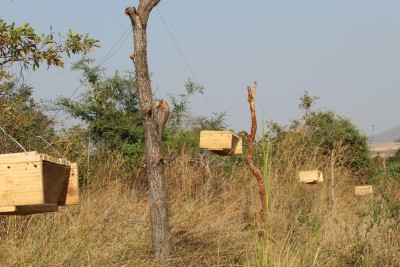 Beehive fencing is typically comprised of a series of Langstroth-style beehives on a strong wire about 10m (~32ft) apart from one another around the perimeter of crops. Other hive styles include Kenyen top beehives and traditional log beehives. The beehives are securely fastened upon the wire, but when an elephant tries to breach the fence line, the beehives shake. When the honeybees emerge to defend their hives, the elephant retreats, leaving the farmland safe. Rather quickly, elephants learn not to approach that area at all because of the potential danger. According to a research study led by Dr. Lucy King of Oxford University and Save the Elephants, beehive fencing successfully prevented ~80% of elephants from breaching farms in Kenya (2017). Almost a decade later, she continues to expand beehive fencing throughout areas where farmers are most vulnerable to elephant conflict. As a leading voice in the field, King consistently works directly with farmers interested in trying beehive fencing as a mitigation method, publishes her research to help others begin or sustain beehive fencing programs, and delivers informative presentations on the subject. (Watch a webinar featuring Dr. King and Aashman Wasan presented by the International Elephant Foundation here.)
Beehive fencing is typically comprised of a series of Langstroth-style beehives on a strong wire about 10m (~32ft) apart from one another around the perimeter of crops. Other hive styles include Kenyen top beehives and traditional log beehives. The beehives are securely fastened upon the wire, but when an elephant tries to breach the fence line, the beehives shake. When the honeybees emerge to defend their hives, the elephant retreats, leaving the farmland safe. Rather quickly, elephants learn not to approach that area at all because of the potential danger. According to a research study led by Dr. Lucy King of Oxford University and Save the Elephants, beehive fencing successfully prevented ~80% of elephants from breaching farms in Kenya (2017). Almost a decade later, she continues to expand beehive fencing throughout areas where farmers are most vulnerable to elephant conflict. As a leading voice in the field, King consistently works directly with farmers interested in trying beehive fencing as a mitigation method, publishes her research to help others begin or sustain beehive fencing programs, and delivers informative presentations on the subject. (Watch a webinar featuring Dr. King and Aashman Wasan presented by the International Elephant Foundation here.)
Like many animals, elephants will actively avoid honeybees. Despite their thick skin, elephants have sensitive areas that are susceptible to stings, including around their trunks, mouths, eyes, and underbellies. When elephants disturb their beehives, honeybees will even seek out these vulnerable areas to sting so that their defense is as effective as possible despite the extremely obvious size difference. “Elephants are really astute observational learners,” explains Alinda Dygert, Elephant Care Specialist at the Rosamond Gifford Zoo. “[In an elephant herd,] if mom or grandma has an adverse reaction to bees, watching that reaction to honeybees is going to teach their offspring to avoid honeybees. An elephant doesn’t need to have a bad experience with honeybees directly to know to stay away from them.”
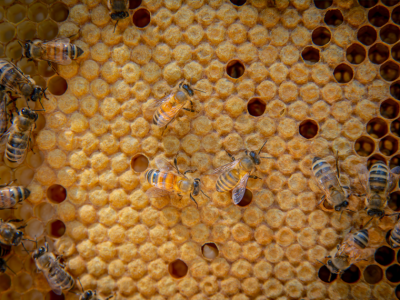 The elephants living at the zoo are no exception. Case in point, Dygert recalls a summer when male Asian elephant Doc exhibited the very same aversion to stinging insects that help make beehive fencing a conservation success. When Doc suddenly refused to shift through one specific gate, his caretakers were stumped. Doc was adamant. The cause of his abrupt change in behavior? Turns out, bees had taken up residence near the top of the gate in a massive, active hive. Although the elephant care team hadn’t yet noticed the nest, Doc had. He certainly wasn’t going to risk walking through the door, agitating the nest, and getting stung, no matter how nicely the team asked him to shift! Thankfully, once the team noticed and took care of the nest, Doc eventually resumed shifting after his caretakers helped him understand the bees were gone.
The elephants living at the zoo are no exception. Case in point, Dygert recalls a summer when male Asian elephant Doc exhibited the very same aversion to stinging insects that help make beehive fencing a conservation success. When Doc suddenly refused to shift through one specific gate, his caretakers were stumped. Doc was adamant. The cause of his abrupt change in behavior? Turns out, bees had taken up residence near the top of the gate in a massive, active hive. Although the elephant care team hadn’t yet noticed the nest, Doc had. He certainly wasn’t going to risk walking through the door, agitating the nest, and getting stung, no matter how nicely the team asked him to shift! Thankfully, once the team noticed and took care of the nest, Doc eventually resumed shifting after his caretakers helped him understand the bees were gone.
Doc’s natural behavior as an individual elephant avoiding bees is significant for the conservation of wild elephants and overall goal to decrease HEC. Animal care experts and researchers take what they learn about behavioral patterns from animals in human care and apply that knowledge to improve the quality of life for both wild animals and human populations sharing the same wild space.
It’s important to remember that much like elephants and humans, honeybees are not a neutral party in this triangulated relationship. Their ability to deter elephants from trespassing on farmland hinges on the honeybees’ healthy presence within the hives. Their presence within the hives, however, is contingent on the care offered by farmers. Beekeeping is a labor-intensive endeavor, requiring careful and constant monitoring of the honeybees. To learn how to keep bees successfully, farmers need to be provided with proper training and resources to adopt the practice.
Ironically, it’s perhaps the bees and the care they need to thrive that are the initially overlooked element to the coexistence equation. “When we talk about beehive fencing as a successful method of conservation, we often talk about it in terms of humans coexisting with elephants, but really, it’s about humans, elephants, and bees coexisting,” says Liam McCarthy, Herpetology/Aquariums/Terrestrial Invertebrates Care Specialist at the Rosamond Gifford Zoo. “The bees are an integral part of this interaction, and it takes a lot of coordination and effort to learn these techniques and create a place where the bees want to be and can thrive.”
For instance, the construction of the hives is designed to keep the bees safe even in the event of an elephant breaching the fence line as a failsafe. The wire that links hives runs through the inside of hives in an interwoven pattern. That way, if an elephant were to break through the connecting wire, the hives are reinforced to ensure they will not fall to the ground. This protects the beehive from being destroyed by the fall or ravaged by other insects, such as wax moths, or ground-dwelling animals, such as honey badgers. In areas that see particularly hot sun, hives are constructed with shade covering so that bees can stay relatively cool.
When the bees thrive, so do the humans who take care of them. Unlike other HEC mitigation techniques, beehive fencing offers farmers a source of extra income. Farmers can harvest and sell the honey.
For beehive fencing to be a success, farmers interested in adopting beehive fencing must be provided with ample training about proper hive management practices, honey harvesting methods, key information about bee behavior, pest control, safety guidelines, and the financial support needed to kickstart and maintain hives. “Supporting farmers so that they can support their bees doubles as support for the elephants,” McCarthy explains. He is currently enrolled in Cornell University’s Master Beekeeping Certificate Program. To reduce costs and beekeeping labor, some beehives within farmers’ fence lines are decoys. As long as the hives look, sound, or smell like active beehives, elephants will avoid the structure because of the association.
Even when farmers do everything possible to sustain their honeybee populations, it is not guaranteed that the honeybee colonies remain in the hive. Droughts, which are more and more frequent due to climate change, will negatively impact honeybee populations. If the bees are not able to access enough water for themselves, and/or if the surrounding area can no longer sustain enough plant life for them to feed, the bees will abscond from the hive. This is to say that the bees will leave their hive behind to start another in a more suitable location.
No beehives in the hive? No reason for elephants to avoid the crops inside the beehive fence line. And no honey for farmers to harvest or to sell.
The personalities of the honeybees also affect the efficacy of the beehive fencing. For instance, more success has been documented in deterring African elephants than Asian elephants. One factor in that difference might be due to African honeybees often displaying more aggressive behaviors than the European honeybees that populate Asia. The more reactive the honeybees are to the elephants, the more reason elephants have to flee the honeybees. 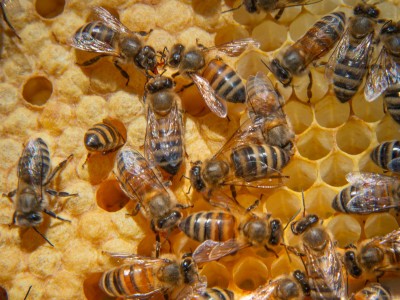
“You can’t understate the complex intricacies of a hive’s social life,” beams McCarthy. “Each bee has a defined role so they can all work together to thrive. It’s very organized, very specific.” Bees are even able to recognize visual symbols, which is why each hive at the Rosamond Gifford Zoo is marked with a distinct colored shape to help the bees recognize their home hives. “We’re constantly monitoring their behavior as well as honey output to gauge how they are doing and what we need to adjust,” he says. Routine observations include tracking the bees’ movements, population numbers, and activity levels.
Currently, three European honeybee hives reside at the Rosamond Gifford Zoo. A trio of full-time animal care specialists, including Dygert, McCarthy, and Hoofstock Care Specialist Eli Capri, and a handful of part-time animal care specialists have undertaken beekeeping duties and are responsible for the hives. “The beehives are a wonderful opportunity for our part-time colleagues to gain hands-on experience and professional growth,” describes Dygert. “There’s a lot of training involved with zookeeping before you have the chance to work with animals closely and autonomously, but beekeeping is a great way for part-time keepers to get involved and own the work they perform without limitations.”
 In addition to ensuring the hives thrive, the team has been able to harvest surplus honey, which has been used in animal enrichment for an array of species, most notably Andean bear Bjorn. Some of the honey has been enjoyed by zoo guests when it is used in dishes featured at Gourmet Pairing Dinner events hosted monthly by Catering at the Zoo (CATZ) in the Banquet Room on zoo grounds. The Rosamond Gifford Zoo’s chapter of the American Association of Zoo Keepers (AAZK) is currently exploring possibilities to process honey and/or wax as fundraising for the group. AAZK is a professional group of zookeepers that works to advance excellence in the profession, to foster effective communication beneficial to animal care, to support deserving conservation projects, and to promote the preservation of our natural resources and animal life. Stay tuned for more information!
In addition to ensuring the hives thrive, the team has been able to harvest surplus honey, which has been used in animal enrichment for an array of species, most notably Andean bear Bjorn. Some of the honey has been enjoyed by zoo guests when it is used in dishes featured at Gourmet Pairing Dinner events hosted monthly by Catering at the Zoo (CATZ) in the Banquet Room on zoo grounds. The Rosamond Gifford Zoo’s chapter of the American Association of Zoo Keepers (AAZK) is currently exploring possibilities to process honey and/or wax as fundraising for the group. AAZK is a professional group of zookeepers that works to advance excellence in the profession, to foster effective communication beneficial to animal care, to support deserving conservation projects, and to promote the preservation of our natural resources and animal life. Stay tuned for more information!
While honey is a great bonus for everyone to enjoy and a signal that the hives are well-maintained and experiencing excellent welfare, honey production isn’t the overall goal of the Rosamond Gifford Zoo’s hives. Instead, according to Leisje Meates, Collection Manager of Herpetology/Aquariums/Terrestrial Invertebrates at the Rosamond Gifford Zoo, the honeybee hives serve to tell the story of elephant conservation through HEC mitigation overseas and to demonstrate how vital pollinators are to our planet more broadly. Animals that routinely pollinate plants, such as bees, butterflies, moths, bats, beetles, and hummingbirds, play a direct role in sustaining natural ecosystems and agricultural production worldwide. “When we encourage people to connect with honeybees, we hope that they’ll be more excited to connect with other pollinators, too,” she explains. “Whether that’s creating pollinator-friendly spaces at home, helping to clean up and protect the wild places where pollinators live, or even just noticing pollinators in your day-to-day life.”
By having our elephants and beehives side by side, the Rosamond Gifford Zoo showcases the important conservation work of beehive fencing as a tool that saves elephants, protects humans, supports honeybees, and brings us all a little closer to nature as we all keep our distance.
Works Cited
Gunaryadi, D. (2017). Community-based human–elephant conflict mitigation: The value of an evidence-based approach in promoting the uptake of effective methods. Public Library of Science. https://doi.org/10.1371/JOURNAL.PONE.0173742. Accessed 12 June 2025.
King, L.E., Lala, F., Nzumu, H., et al. (2017). Beehive fences as a multidimensional conflict-mitigation tool for farmers coexisting with elephants. The Journal of the Society for Conservation Biology. 31(4), https://doi.org/10.1111/COBI.12898. Accessed 11 June 2025.
Nabanita, P and Chakraborty, S. (2021). Efficacy of different human-elephant conflict prevention and mitigation techniques practiced in West Bengal, India. Notulae Scientia Biologicae. 13(3), https://doi.org/10.15835/nsb13311017. Accessed 11 June 2025.
Rodrigo, R. (2025). A battle for survival: Sri Lanka’s escalating Human Elephant Conflict. Newswire. https://www.newswire.lk/2025/03/31/a-battle-for-survival-sri-lankas-escalating-human-elephant-conflict/. Accessed 11 June 2025.


